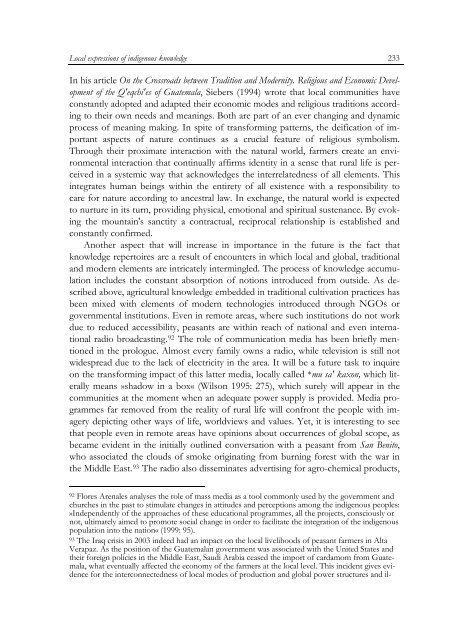The cultural context of biodiversity conservation - Oapen
The cultural context of biodiversity conservation - Oapen
The cultural context of biodiversity conservation - Oapen
Create successful ePaper yourself
Turn your PDF publications into a flip-book with our unique Google optimized e-Paper software.
Local expressions <strong>of</strong> indigenous knowledge<br />
In his article On the Crossroads between Tradition and Modernity. Religious and Economic Development<br />
<strong>of</strong> the Q'eqchi'es <strong>of</strong> Guatemala, Siebers (1994) wrote that local communities have<br />
constantly adopted and adapted their economic modes and religious traditions according<br />
to their own needs and meanings. Both are part <strong>of</strong> an ever changing and dynamic<br />
process <strong>of</strong> meaning making. In spite <strong>of</strong> transforming patterns, the deification <strong>of</strong> important<br />
aspects <strong>of</strong> nature continues as a crucial feature <strong>of</strong> religious symbolism.<br />
Through their proximate interaction with the natural world, farmers create an environmental<br />
interaction that continually affirms identity in a sense that rural life is perceived<br />
in a systemic way that acknowledges the interrelatedness <strong>of</strong> all elements. This<br />
integrates human beings within the entirety <strong>of</strong> all existence with a responsibility to<br />
care for nature according to ancestral law. In exchange, the natural world is expected<br />
to nurture in its turn, providing physical, emotional and spiritual sustenance. By evoking<br />
the mountain's sanctity a contractual, reciprocal relationship is established and<br />
constantly confirmed.<br />
Another aspect that will increase in importance in the future is the fact that<br />
knowledge repertoires are a result <strong>of</strong> encounters in which local and global, traditional<br />
and modern elements are intricately intermingled. <strong>The</strong> process <strong>of</strong> knowledge accumulation<br />
includes the constant absorption <strong>of</strong> notions introduced from outside. As described<br />
above, agri<strong>cultural</strong> knowledge embedded in traditional cultivation practices has<br />
been mixed with elements <strong>of</strong> modern technologies introduced through NGOs or<br />
governmental institutions. Even in remote areas, where such institutions do not work<br />
due to reduced accessibility, peasants are within reach <strong>of</strong> national and even international<br />
radio broadcasting. 92 <strong>The</strong> role <strong>of</strong> communication media has been briefly mentioned<br />
in the prologue. Almost every family owns a radio, while television is still not<br />
widespread due to the lack <strong>of</strong> electricity in the area. It will be a future task to inquire<br />
on the transforming impact <strong>of</strong> this latter media, locally called *mu sa' kaxon, which literally<br />
means »shadow in a box« (Wilson 1995: 275), which surely will appear in the<br />
communities at the moment when an adequate power supply is provided. Media programmes<br />
far removed from the reality <strong>of</strong> rural life will confront the people with imagery<br />
depicting other ways <strong>of</strong> life, worldviews and values. Yet, it is interesting to see<br />
that people even in remote areas have opinions about occurrences <strong>of</strong> global scope, as<br />
became evident in the initially outlined conversation with a peasant from San Benito,<br />
who associated the clouds <strong>of</strong> smoke originating from burning forest with the war in<br />
the Middle East. 93 <strong>The</strong> radio also disseminates advertising for agro-chemical products,<br />
92 Flores Arenales analyses the role <strong>of</strong> mass media as a tool commonly used by the government and<br />
churches in the past to stimulate changes in attitudes and perceptions among the indigenous peoples:<br />
»Independently <strong>of</strong> the approaches <strong>of</strong> these educational programmes, all the projects, consciously or<br />
not, ultimately aimed to promote social change in order to facilitate the integration <strong>of</strong> the indigenous<br />
population into the nation« (1999: 95).<br />
93 <strong>The</strong> Iraq crisis in 2003 indeed had an impact on the local livelihoods <strong>of</strong> peasant farmers in Alta<br />
Verapaz. As the position <strong>of</strong> the Guatemalan government was associated with the United States and<br />
their foreign policies in the Middle East, Saudi Arabia ceased the import <strong>of</strong> cardamom from Guatemala,<br />
what eventually affected the economy <strong>of</strong> the farmers at the local level. This incident gives evidence<br />
for the interconnectedness <strong>of</strong> local modes <strong>of</strong> production and global power structures and il-<br />
233

















